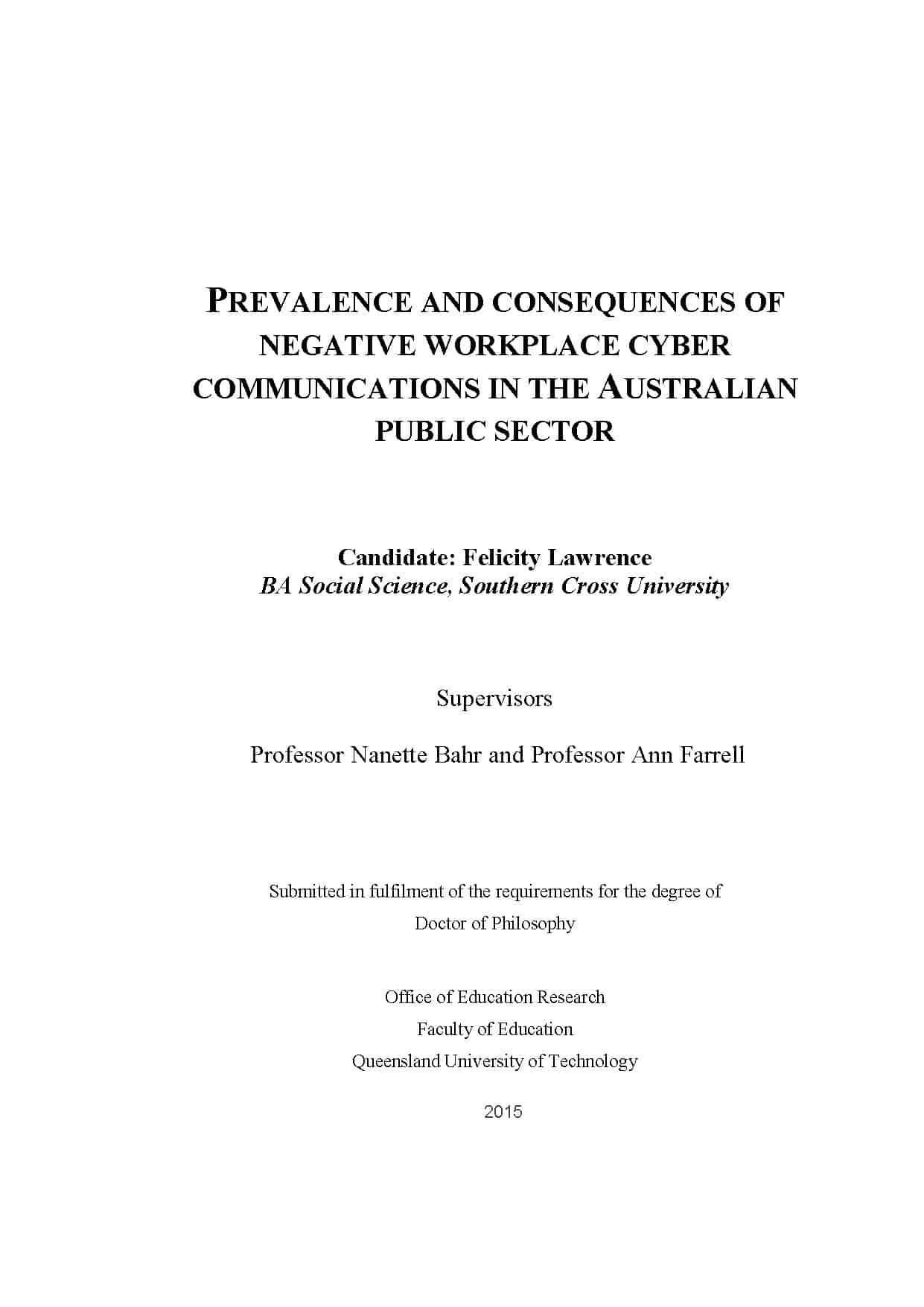http://safetyatworkblog.com/2016/01/18/important-research-into-workplace-cyber-bullying/
SafetyAtWorkBlog
AWARD-WINNING NEWS, COMMENTARY AND OPINION ON WORKPLACE SAFETY AND HEALTH
Important research into workplace cyber-bullying
Last week several Australian news sites reported on a new thesis about public servants and cyber-bullying which is discussed in detail below. The reports are based mostly on amedia release about the research issued by Queensland University of Technology (QUT). What caught my eye was the statement in the one media report that the researcher, DrFelicity Lawrence,
Not true. In the QUT statement, Lawrence stated
“up to” vs “about? This differentiation is important because the lack of clarity creates OHS myths and these myths can misinform policy priorities and public understanding of workplace hazards.
The falsity of the A$36 billion cost figure was addressed in a SafetyAtWorkBlog article in 2012. The original data shows a range of costs estimated at between A$6 billion to A$36 billion and is based on “international studies as a guide”. The QUT statement is correct in stating cost estimates of up to $36 billion, but it is not possible to accept “about $36 billion” as accurate. The writer could also have said “about $6 billion”. As far as this writer knows, Australia still does not have a more accurate estimate of the costs of workplace bullying than the 2010 estimate that allows for a A$30 billion variation!
Thankfully, QUT has provided public access to Dr Lawrence’s thesis on which some of the reports are based. “Prevalence and Consequences of Negative Workplace Cyber Communications in the Australian Public Sector” states that
The relationship with workplace stress brings this research clearly in to the purview of occupational health and safety (OHS). However it is also noted that the research resulted from a lack of existing research into
The investigation of perceptions is often the nature of research in the social sciences and does not invalidate the research but readers must remember that the research is based on a qualitative, subjective base which limits its practical application. Many in the media seem to forget this or diminish its significance. For instance, many articles based on estimates of business confidence imply that this indicates economic problems. The estimates are of business owners feelings and impressions and are as valid as asking a thousand people “what they reckon’s happening”. Such perception studies should be supported by additional research to very the broader social context.
Productivity or Profitability
Lawrence addresses the costs estimates for traditional workplace bullying in the thesis’ introduction and includes a statement about the benefits of reducing bullying costs that reflects a common position that deserves questioning.
Lawrence writes that
The reasoning is sound in the context of the public service (the subject of this thesis) but it is suspected that, in the private sector, OHS-related cost savings are more likely to be used to increase a company’s profits or shareholder return than be used to boost productivity. It seems in many discussions of OHS-related costs that the term productivity is often used when profitability would be a more accurate term.
Cyber-bullying is different
Lawrence makes the very important point that cyber-bullying bullying should be considered separately to the traditional face-to-face bullying as the transmission method is different and the potency of the bullying can be much greater and more pervasive (page 5). OHS practitioners and professionals need to look closely at this differentiation as it will result in very different control and remediation mechanisms even though the manifestation of the harm may be similar.
Lawrence’s brief Background is a fascinating read due to its different slant on workplace bullying however I am not sure that another researcher’s (Strauss) application of bullying to the conduct of Hector in the Trojan War is reasonable. As someone who read classical literature at high school and university, Hector’s actions in war were arrogant, shallow and vicious but not bullying. (That expert on classical literature, Wikipedia, has a different view of Hector: “Homer places Hector as peace-loving, thoughtful as well as bold, a good son, husband and father, and without darker motives.”) And his actions were in the context of a war that lasted over ten years.
In order to define and discuss cyber-bullying Lawrence has to discuss traditional face-to-face bullying. It seems that she has not missed any of the major research papers on workplace bullying in Australia. In fact her interest in cyber-bullying tends to allocate a different level of priority and significance to some of the more familiar workplace bullying research.
Lawrence acknowledges the recent discussions in to the role of “incivility” as an element of workplace bullying and her mind-map of workplace bullying terminology (page 47) is very useful.
A major difference between the old and the new forms of workplace bullying is the anonymity that social media technology allows. This is likely to be an important element in the increased distress that people feel with cyber-bullying. Lawrence paraphrases research by Suler on this anonymity :
Many companies are struggling to deal with workplace bullying so the news that cyber-bullying may be increasing and require additional control measures is not going to be welcome. Lawrence writes about the future and provides a very good example of cyber-bullying’s OHS effects and costs, even though this legal case was pursued under sexual harassment:
Dr Lawrence’s thesis is fascinating and offers a new perspective on workplace bullying and the potential OHS risks presented by cyber-bullying. My pedantic annoyance at media reports about this research provided a trail to a, thankfully, public thesis that has expanded my understanding of how cyber-bullying can operate in the work environment.
It is also refreshing to read research into this issue that does not focus on cyber-bullying by high school students. Lawrence’s thesis gives cyber-bullying a clear workplace (adult?) context that will prevent businesses from dismissing the activity as not work-related.
Finding this thesis has reinforced my commitment to look for original OHS research and documents and not rely solely on media reports.

No comments :
Post a Comment